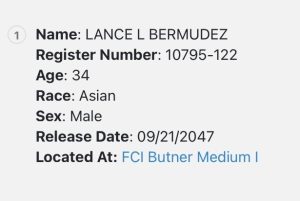Years before convicted racketeering boss Michael J. Miske, Jr. was found dead in his cell at Honolulu’s Federal Detention Center, one of his closest associates told federal investigators Miske had spoken about the possibility of taking his own life if he were facing prison time. It is the first and, so far, the only documented indication Miske had ever contemplated suicide. It has not been previously reported.
Miske, 50, died December 1, 2024, while awaiting sentencing. He had been convicted on 13 of 16 counts after a six month jury trial, including several counts carrying a sentence of life in prison.
The nature of Miske’s death remains unresolved. Published reports said sources indicated he had killed himself. The medical examiner found he had died of a fentanyl overdose, but tentatively ruled it “accidental,” according to public statements from the medical examiner’s office. A final determination was deferred pending results of a further ongoing investigation, and a death certificate later filed in federal court as part of an ongoing civil forfeiture lawsuit omitted any mention of the cause of death.
In an earlier post here, I noted that Miske was not known to be a hard drug user, and had pushed a number of his associates to enter drug rehab, sometimes repeatedly. This appears to make an “accidental” overdose a less likely explanation, although the specter of life in prison could alter one’s view of drug use.
And Miske being a victim of a murder plot seems unlikely, as he had forged alliances with several prison gangs whose members reportedly retaliated against those who had testified against Miske, and also likely looked out for his safety.
The newly available reference to a witness statement about Miske’s mention of suicide appears in a 2019 affidavit by a federal agent submitted to the Federal District Court in support of an application for a search warrant. The search warrant, part of what was the ongoing multi-agency investigation of what prosecutors were calling the “Miske Enterprise” that eventually led to his arrest and conviction, remained sealed and unavailable to the public until earlier this year.
The undated statement is attributed to a cooperating witness identified in the document only as “CW1.” However, numerous other pieces of information in the affidavit match Wayne Miller, who grew up in the same Waimanalo neighborhood as Miske. The two become good friends despite a difference in age, and Miske once referred to Miller as one of his few “true” friends.
Miller served a 10-year prison sentence for the armed robbery of a windward credit union, and after his release quickly went to work for Miske. He soon became Miske’s top lieutenant, according to other witness statements, and admitted to being part of Miske’s organization from 2014 until sometime in 2018, although their relationship frayed over time.
According to the agent’s sworn affidavit:
According to CWl, MISKE was waiting for the day of his arrest by law enforcement. He believed serving time in prison was inevitable, which caused him to be suicidal. MISKE spoke about hanging himself in prison.
This represented a turnaround from Miske’s reported attitude in August 2017 when the government first disclosed it was investigating his role in an alleged murder-for-hire plot that led to the kidnapping and disappearance of Jonathan Fraser. Miske responded at that time by lawyering up, hiring experienced defense attorneys Thomas “Tommy” Otake and Lynn Panagakos to handle his case.
Miller later told investigators, “Miske trusted his legal team and planned to ‘ride it out;’ a reference to enduring any criminal proceedings with faith that his legal team would mount a successful defense,” according to the same 2019 affidavit.
Miller started cooperating with investigators no later than June 1, 2017, according to court filings by Lynn Panagakos, one of Miske’s lead defense attorneys. Miller stepped up his cooperation after he was arrested on drug charges on August 1, 2018. For more than a year, Miller tried to play both sides, providing information to investigators while continuing to use and deal quantities of drugs at the same time.
A search of court records, including pretrial motions and responses, more than 75 search warrants that were unsealed and made public by court order, and available transcripts of trial testimony, failed to turn up any other indication Miske had ever harbored suicidal thoughts.
However, Miske’s father, Michael John Miske Sr., was 28 when he took his own life in 1980 by drinking a cyanide concoction. He was reportedly depressed and despondent over the breakup of his marriage and the prospect of losing both his wife and son. Mike Jr. was just 6-years-old.
Whatever the cause, Miske’s death prior to sentencing led to an order by Judge Derrick Watson in February dismissing the criminal case. The entire matter, from the original indictment to conviction, including jury’s finding that Miske’s estate should be forfeited to the government, simply disappeared with Miske’s death, at least in a legal sense.
This points to another factor that could be relevant. In the matter of the forfeiture of Miske’s assets, estimated to be worth as much as $25 million, the disappearance of the criminal case had one direct and dramatic result. Had Miske lived and been unsuccessful at challenging the jury’s verdict on appeal, the entire amount would have gone to the government, as the jury had already ruled on the matter of criinal forfeiture.
After his death, however, the government has to try to prove its right to claim Miske’s assets by filing a civil forfeiture lawsuit, now pending in Honolulu’s Federal District Court.
However, the prospect of another long and costly trial with an uncertain outcome has prompted federal lawyers to enter into negotiations with the attorney representing Miske’s personal trust, which also claims the assets. Both sides say they hope to reach a agreement to divide the estate, with an undetermined amount to go to the Miske’s trust’s sole beneficiary, his granddaughter.
There is no indication in the existing record whether or not Miske knew that his death would create this legal possibility of grabbing back some of his assets from the government, an outcome which now appears highly likely.
The reference to suicide in a witness statement from years before Miske’s death adds a small but telling detail to a story that remains unresolved. It suggests he may have long anticipated the possibility of dying behind bars, though whether his death was intentional, accidental, or something else entirely is still unclear.
What is clear is that Miske’s death halted the government’s criminal case and transformed the battle over his assets into a civil one. The legal fight now continues in his absence, even as the human dimensions of his story—ambition, loyalty, betrayal, and loss—continue to unfold in the shadows he left behind.


